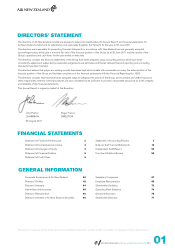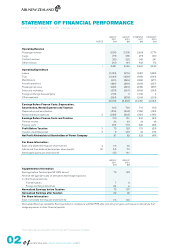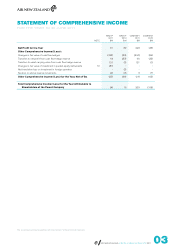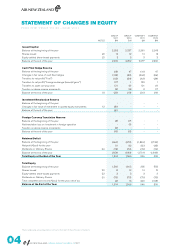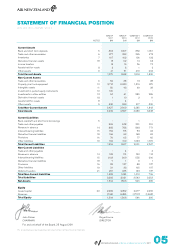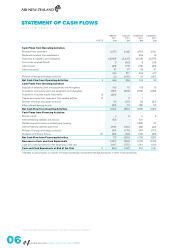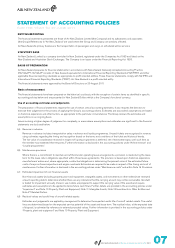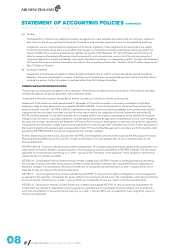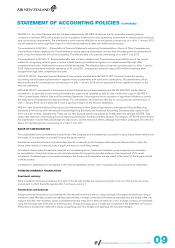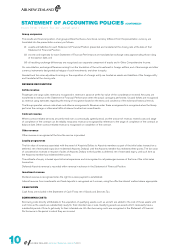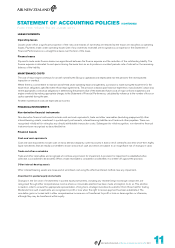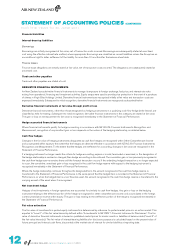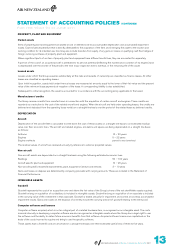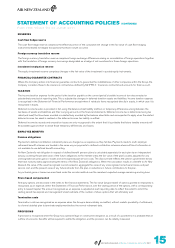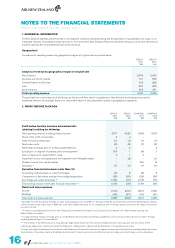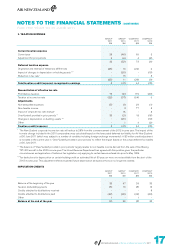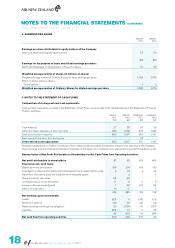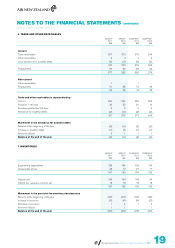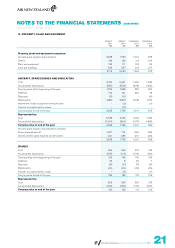Air New Zealand 2011 Annual Report Download - page 13
Download and view the complete annual report
Please find page 13 of the 2011 Air New Zealand annual report below. You can navigate through the pages in the report by either clicking on the pages listed below, or by using the keyword search tool below to find specific information within the annual report.
LEASE PAYMENTS
Operating leases
Leases under which a significant proportion of the risks and rewards of ownership are retained by the lessor are classified as operating
leases. Payments made under operating leases (net of any incentives received) are recognised as an expense in the Statement of
Financial Performance on a straight-line basis over the term of the lease.
Finance leases
Payments made under finance leases are apportioned between the finance expense and the reduction of the outstanding liability. The
finance expense is allocated to each period during the lease term so as to produce a constant periodic rate of interest on the remaining
balance of the liability.
MAINTENANCE COSTS
The cost of major engine overhauls for aircraft owned by the Group is capitalised and depreciated over the period to the next expected
inspection or overhaul.
Where there is a commitment to maintain aircraft held under operating lease arrangements, a provision is made during the lease term for the
lease return obligations specified within those lease agreements. The provision is based upon historical experience, manufacturers’ advice and,
where appropriate, contractual obligations in determining the present value of the estimated future costs of major airframe inspections and
engine overhauls by making appropriate charges to the Statement of Financial Performance, calculated by reference to the number of hours or
cycles operated during the year.
All other maintenance costs are expensed as incurred.
FINANCIAL INSTRUMENTS
Non-derivative financial instruments
Non-derivative financial instruments include cash and cash equivalents, trade and other receivables (excluding prepayments), other
interest-bearing assets, investment in quoted equity instruments, interest-bearing liabilities and trade and other payables. These are
recognised initially at fair value plus any directly attributable transaction costs. Subsequent to initial recognition, non-derivative financial
instruments are recognised as described below.
Financial Assets
Cash and cash equivalents
Cash and cash equivalents include cash on hand, demand deposits, current accounts in banks net of overdrafts and other short-term highly
liquid investments that are readily convertible to known amounts of cash and which are subject to an insignificant risk of changes in value.
Trade and other receivables
Trade and other receivables are recognised at cost less any provision for impairment. A provision for impairment is established when
collection is considered to be doubtful. When a trade receivable is considered uncollectible, it is written-off against the provision.
Other interest-bearing assets
Other interest-bearing assets are measured at amortised cost using the effective interest method, less any impairment.
Investment in quoted equity instruments
Changes in the fair value of investments in quoted equity instruments, including any related foreign exchange component, are
recognised through other comprehensive income where an irrevocable election has been made at inception to do so. This election
is made in order to ensure the appropriate representation of long-term, strategic investments as distinct from those held for trading.
Dividends from such investments are recognised in profit or loss when the right to receive payment has been established. The
cumulative gains or losses held in other comprehensive income are not transferred to profit or loss on derecognition or otherwise,
although they may be transferred within equity.
AIR NEW ZEALAND ANNUAL FINANCIAL RESULTS 2011
STATEMENT OF ACCOUNTING POLICIES (CONTINUED)
FOR THE YEAR TO 30 JUNE 2011


